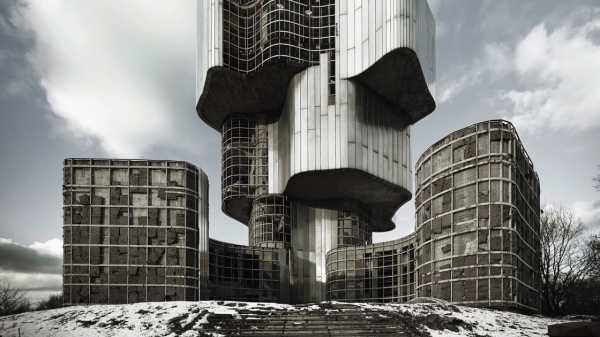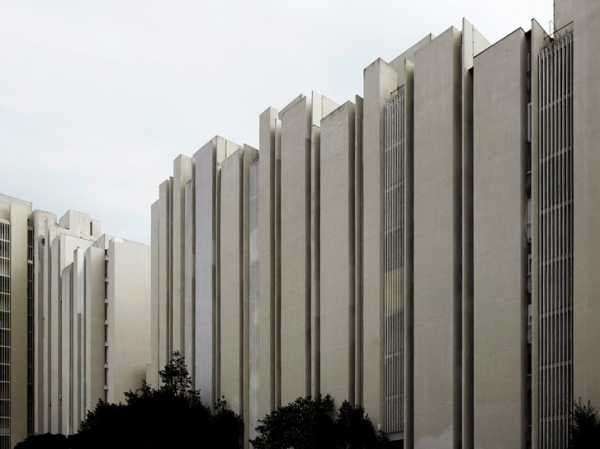
At the back of the Historical Museum of Bosnia and Herzegovina, in Sarajevo, is a café called Tito. Inside, a bronze bust of the man himself, Josip Broz Tito, presides over a red room bedecked with Second World War-era military paraphernalia. The lampshades are made from soldiers’ helmets. It’s a fun but rather kitsch place to be located in the city’s finest, and most zealous, modernist building. Formerly known as the Museum of the Revolution, the building consists of a blind marble slab that appears to float above a glazed ground floor. Completed in 1963, it was designed by Boris Magaš, with Edo Šmidihen and Radovan Horvat, in the International Style.
Today, the building is far from its serene best. That marble façade is like a smile full of chipped teeth. On seeing that the building makes a minor appearance in the Museum of Modern Art’s new exhibition “Toward a Concrete Utopia: Architecture in Yugoslavia, 1948–1980,” my first thought was that perhaps the powers that be in Sarajevo will finally consider it for renovation. That would be a happy outcome, but there are higher stakes here. For the curators, the aim is for Yugoslavian modernism to find its place in the architectural canon (which, after all, MoMA has done more than any museum to create). While there is no doubt that the extraordinary output of socialist Yugoslavia deserves that place, there is also a risk that the architecture’s true significance is not fully absorbed.
Reading the broadly positive reviews, you’d be forgiven for thinking that the exhibition’s timeliness is linked to the fact that we are in the midst of a full-blown Brutalist revival. And it’s true that nostalgia for the raw concrete surfaces of the nineteen-sixties and seventies has seeped into the aquifer and is gushing out in Instagram feeds, coffee-table books, and music videos. The exhibition itself plays this up with a series of newly commissioned photographs by Valentin Jeck that luxuriate in stained concrete and gunmetal skies. (Never mind that we are in southern Europe here, lapped by the Adriatic.) What one misses by seeing this exhibition as stylistically fashionable is the political content. If Brutalism is loved once more today for its heft and material honesty, it is also so closely associated with social democracy that to be nostalgic for one is to be nostalgic for the other. In the case of Yugoslavia, there is just as much cause to interrogate our newfound interest, because the architecture expressed one of the great political experiments of the modern era.
Yugoslavia was defined by its in-betweenness. Established after the Second World War, the Federal People’s Republic of Yugoslavia may have begun life as a Communist state in the Soviet mold, but, in 1948, Tito broke with Stalin and began to reshape the country along less statist lines. What emerged was a political entity that was neither totalitarian communism nor a capitalist democracy but something in the middle—one might call it market socialism. The linchpin of this “third way” socialism was “worker self-management.” Tito was the anti-Stalin, a liberal decentralizer who believed in the “withering of the state.” Self-management meant devolving a certain amount of power to worker collectives—not just in the factories but in any enterprise, even the architecture practices. It may have been a one-party state, but it was also the most sustained effort yet to achieve popular self-governance.
And so Yugoslavia was this strange communist state with shopping centers, decent living standards, relative ease of travel, and British comedy on the TV. That is not to say that it was a utopia—it would eventually collapse under the weight of its contradictions and endemic ethnic divisions—but it was not what your average American thinks of as “communism.” That this “third way” socialism survived into the nineteen-eighties probably had something to do with the fact that it was widely embraced, rather than imposed by the Soviets, as it was elsewhere in Eastern Europe, in part because the Yugoslav Partisans had managed to liberate the country from the Nazis without much need for the Red Army.
That military achievement, at the cost of a million dead, is also one of the reasons that Yugoslavian architecture has started to attract wider attention. In 2013, photographs of spomenici—memorials, mostly commemorating the struggle against Fascism—started to spread like wildfire across the architecture-loving Internet. These abstract, boldly expressive monuments, thousands of which once dotted the Yugoslavian countryside, were received with wide eyes, as if a lost civilization had suddenly yielded a new architectural language. And it is true that many of the country’s great talents, including the artist Vojin Bakić and the architect Bogdan Bogdanović, were engrossed in creating these extraordinary landscape works. No wonder they were exoticized. But they were also explicitly an iconography of nation-building, points of collective pride and solidarity. More instructive to today’s situation—when architecture has been thoroughly privatized—is the architecture of self-management.
In the words of Edvard Kardelj, the chief theorist of self-management, the system offered a “profound cultural and ethical revolution . . . a transformation of the complete consciousness of the working man.” Bearing in mind that Yugoslavia had been an undeveloped, largely agrarian economy before the war, the task of rebuilding and modernizing was not just physical but mental. One could not rely on the workers to self-manage without educating them. And so one of the key strands of the rebuilding effort was schools, from kindergartens to so-called worker universities. By 1959, there were a hundred and twenty-nine such universities, the finest of which was in the heart of New Zagreb, in the Croatian capital. Designed by Radovan Nikšić and Ninoslav Kučan, it was a paragon of modernist style. But, more than that, it provided a dense set of activities in flexible spaces with fluid circulation—there was nothing rigid or dogmatic about it. Tito was sufficiently impressed that, in 1963, once relations with the U.S.S.R. had eased a little, he took Khrushchev there to show off the achievements of his non-Soviet socialism. (The Russian was impervious: “The workers should stay at the factory bench,” he countered.)
This push toward education included cultural centers and museums. Some of these were brilliantly original interpretations of these building types, such as the wonderful Museum of Contemporary Art in Belgrade, designed by Ivan Antić and Ivanka Raspopović. Composed of a grid of crystalline forms with angular skylights, it was a striking symbol of the country’s belief in modern art and architecture. Early on, and especially after Yugoslavia’s expulsion from Cominform, in 1948, the authorities had rejected the socialist realism espoused in the U.S.S.R. as unfit to represent a progressive society. The current of European and American modernism ran deep, and Yugoslavian architects, many of whom were trained in the West, proved that they could make an original contribution to that discourse. In 1958, Vjenceslav Richter flaunted this unique brand of modernism on the world stage with his design for the Yugoslav Pavilion, at the Brussels World’s Fair. This intricate structure was an exercise in elegance and clarity (and is still in use today, as a college in a small Belgian town).
Yugoslavia’s divergence from the Iron Curtain’s architectural culture was remarked on by Harrison Salisbury, a former Moscow bureau chief for the Times who was on a temporary stint in the Balkans, in 1957. “To a visitor from eastern Europe a stroll in Belgrade is like walking out of a grim barracks of ferro-concrete into a light and imaginative world of pastel buildings, ‘flying saucers’ and Italianate patios,” he wrote. “Nowhere is Yugoslavia’s break with the drab monotony and tasteless gingerbread of ‘socialist realism’ more dramatic than in the graceful office buildings, apartment houses and public structures that have replaced the rubble of World War II.”
Indeed, it was in Belgrade, nearly ten years ago, that it first dawned on me that socialist Yugoslavia’s architectural project was in a category of its own. Strolling the avenues of New Belgrade, with its ranks of concrete tower blocks, it was not the architecture that drew my attention at first. It was my sense of comfort—the prevailing air of normality. In most of the mass-housing projects I have visited, whether in Europe, South America, New York, or Moscow, one is likely to be aware of one of two things: class or neglect (and often both). There were no class distinctions in New Belgrade because this was not social housing; it was just housing. Many of the heroic housing projects in the West became ghettoized, or were left to deteriorate—some classics have been demolished. At the same time, these were not the repetitive, mass-produced housing blocks of Russia’s microrayon suburbs. They were more socially idealistic than the West, more architecturally inventive than the East.
In Yugoslavia, the right to housing was enshrined in law. And yet two factors distinguished its effort in building mass housing from those in other socialist countries. The first was that this was not just centralized, state-built housing. In fact, following new legislation, in 1960, the housing boom was driven by competitive house-building firms (self-managed, naturally) aiming at a market of institutions seeking homes for their employees. These were subsidized by the state but there was no state-owned property; it was “social property.” Second, Yugoslavian housing was not standardized. There were certainly prefabricated systems in use, but these were highly flexible and encouraged the diversity of housing types. (This was a far cry from the Khrushchyovkas, in Russia—the standardized blocks of Khrushchev’s great house-building drive—which left the architects nothing to do except arrange them in the landscape.)

The Braće Borozan building block, in Split, Croatia. Individualism, rather than uniformity, was encouraged in Yugoslavian mass-housing projects.
Photograph by Valentin Jeck / MoMA
Most of the housing in Yugoslavia—in fact, most major buildings in general—were the result of architectural competitions, which was another reason that the output was so diverse. As a Slovenian architect told me recently, such levels of bespoke design without mass production should not really have been feasible, but, somehow, it happened. There was also a great deal of thought put into the apartments. Rather than uniformity, individualism was encouraged. Open, flexible layouts were highly popular, with movable partition walls and multipurpose rooms—all ideas that remain current. The quality of these apartments was one of the high points of Yugoslavian self-management. And it resulted in modernism being baked into the national psyche. I’ll always remember the mother of a friend from Sarajevo visiting her daughter in London and being relieved to find her living in a social-housing tower block, and not one of those poky Victorian houses—the exact inverse of London snobbery.
If New Belgrade followed a classic Corbusian model of towers set in parkland, then a more novel approach to urban planning was developed in the Croatian city of Split. The modern part of the city, known as Split 3, was built in the nineteen-seventies to house fifty thousand people. Here, a number of different architects contributed a dense layout of imposing housing blocks. One set in particular, by Ivo Radić, looks like something out of “Blade Runner,” with its plate armor of sunscreens. And, yet, what is striking about Split 3 is how the whole scheme is woven together by gracious, pedestrian streets lined with gardens and local Dalmatian stone.
What is now the Croatian coastline (most of the former Yugoslav republics barely get a sniff of the Adriatic) was also the place where the Venn diagram of East and West overlapped—on the beach. As Life magazine put it, in 1966, “Long the political maverick of the Communist world, Yugoslavia has plunged into competitive western-style tourism on a scale that is positively heretical.” That year, it was expecting three million tourists, including a hundred thousand Americans. This certainly made it unique in the “Communist world,” but, again, the social approach to the new hotels and resorts being built marked them out as the expression of a political philosophy. Resorts were designed to be open and free-flowing, to encourage inclusivity and participation—far from the “exclusive” havens of today’s tourism. Even at the high-end Haludovo Hotel complex, designed by Boris Magaš (with an investment from the Penthouse publisher Bob Guccione), on the island of Krk, locals could mingle with international celebrities.
The great achievement of Yugoslavia was in being able to keep collectivism and individualism in some kind of balance. Self-management was far from perfect—it was bureaucratic, and tended to reward Party apparatchiks more than the rest—but still it delivered growth and a progressive society with disposable incomes and access to consumer goods. If MoMA’s exhibition is timely, it is because we have lost any sense of what the balance between the social and the individual might look like. We have also forgotten that alternative political systems are possible. To those interested in forms of direct democracy or the commons, Yugoslavia remains an interesting outlier. Above all, the exhibition reminds us that design can be a tool of social progress.
Perhaps the reason that the architecture of self-management has taken so long to be recognized is because it is difficult to categorize. There is no overriding style. Modernism was arguably a useful device for gelling Yugoslavia, a federation of six republics and two autonomous provinces, together. But the approaches were wonderfully diverse. Heavily influenced by the International Style (exported via touring exhibitions from, yes, MoMA) and, later, Brutalism, the local inflections were relatively unique. There was also a strong sense of regionalism. Juraj Neidhardt, a disciple of Le Corbusier, designed a largely unbuilt master plan for Sarajevo that drew on the city’s historical architecture. He argued, with his fellow-architect Dušan Grabrijan, in their 1957 book “Architecture of Bosnia and the Way to Modernity,” that the traditional Ottoman architecture of Bosnia preëmpted many of the tenets of modernism.
Alas, Neidhardt’s building for the Parliament of Bosnia and Herzegovina in Sarajevo was shelled during the siege of 1992-96, and its tower was subsequently resurfaced in blue-green glass. As I began by saying, the modernist heritage in the city has not been well attended to. And today the city’s new landmarks are either shopping malls or oversized mosques paid for by Gulf states. It is more than enough to make one nostalgic.
In the nineteen-eighties, on the Yugoslavian comedy show “Top Lista Nadrealista” (roughly, The Surrealist Hits Chart), there was a sketch about a guy who goes to a local market to buy architectural blueprints. A vender behind a counter offers him rolls of drawings by the kilo, like so much stewing beef. (“Try this one, it’s fresh!”) It was prescient about what has happened to Sarajevo and other ex-Yugoslav cities in the past decade. It is entirely possible to be nostalgic for a place and a time one never knew—ask the twentysomethings in thrall to Brutalism. In the case of Yugoslavian modernism, and the progressive ideals that underpinned it, mine is nostalgia for an unrepeatable moment. For the idea that political alternatives can exist, however briefly. As the critic and artist Svetlana Boym once wrote, “New utopias are neither political nor artistic, but rather technological and economic. As for politics and philosophy, they play a minor role in the imagination of the future.”
Sourse: newyorker.com






